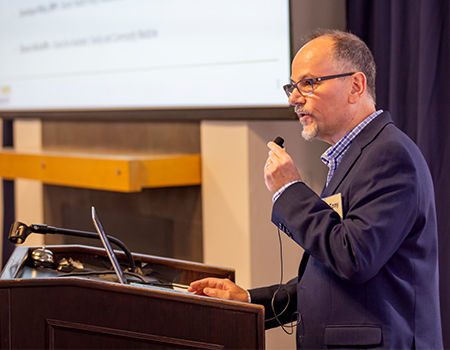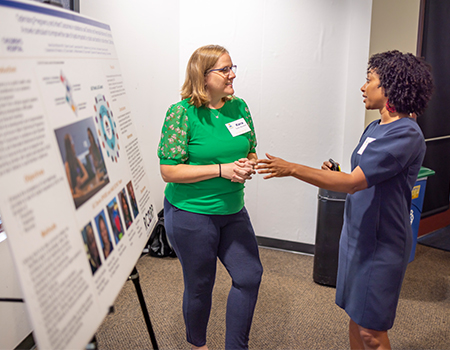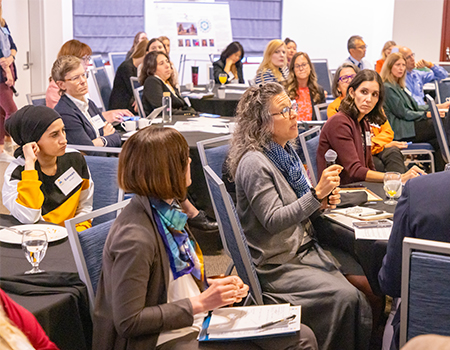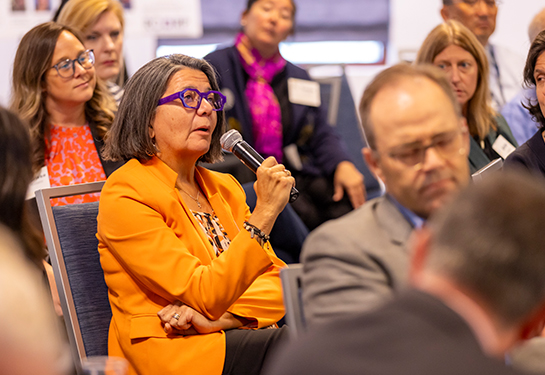UC Davis Health convenes experts to seek solutions to national primary care crisis
Thought leaders gather to offer solutions to make care more accessible to patients and improve job satisfaction for physicians
UC Davis Health is emerging as a national leader in raising awareness about the declining state of primary care, which is adversely affecting a growing number of patients.
Health care experts from across the country have warned in recent years that primary care is in a deepening crisis. They cite factors such as too little funding going to primary care and outdated approaches to providing the funding, which harms primary care practices. The lack of funding is leading to fewer physicians entering the field and others cutting back or leaving practice altogether.

As a result of these and other challenges, patients are struggling to find a primary care doctor and to get timely appointments that don’t feel short or rushed.
UC Davis Health is committed to being part of the solution to address the situation: The Department of Family and Community Medicine and the Center for Healthcare Policy and Research (CHPR) hosted a national gathering Oct. 16-18 in Davis, where experts outlined the growing problems and offered workable solutions.
The event was called the Rev PC Summit — short for “The Summit on Revitalizing Primary Care to Recenter Relationships and Enhance Health.” It brought together dozens of leaders with expertise in primary care, policy, private and government sponsored health insurance coverage, and advocacy perspectives. The attendees also included physicians from the primary care fields of general internal medicine, family and community medicine and general pediatrics.
Addressing challenges facing primary care
The conference was jointly organized by Anthony Jerant, professor and chair of the UC Davis Department of Family and Community Medicine; Richard L. Kravitz, a distinguished professor in the UC Davis Department of Internal Medicine; and Courtney Lyles, a professor in the UC Davis Department of Public Health Sciences and director of CHPR.
Attendees were well-versed on some of the most significant challenges facing primary care medicine:

- A projected national shortfall of up to 40,000 primary care physicians by 2036
- Primary care patients around the country waiting weeks and sometimes months for appointments
- Overburdened physicians frustrated that they don’t have enough time to deliver the high- quality primary care their patients need
- The low, and in many cases decreasing, percentage of health care expenditures from private and public health insurers devoted to primary care.
These challenges were outlined in a guest opinion authored by Jerant and Kravitz in the Sacramento Bee.
“The current state of primary care is bad and getting worse, nationally and in California,” Jerant said, “and this is undermining our health and health care. At the same time, health outcomes in the U.S. grossly underperform other countries that spend less on health care overall, but invest proportionally more in primary care.”
An under-investment in primary care
In public surveys, most people guess that about half of their health insurance premium goes to fund primary care. In reality — across all public and private insurance plans (including Medicare, Medicaid, and insurance companies) in 2023 — only about 6% of the $405 billion in health care spending in California was devoted to primary care. This is despite the fact that primary care accounts for about 35% of all physician visits. Further, in the face of the severe and long-standing under-investment in primary care, both health and health equity in California continued to suffer, according to a report by The Commonwealth Fund.
Further, as the state of primary care has worsened, key indicators of population health in the U.S. have declined: Average life expectancy is going down and maternal mortality is on the rise.
A greater investment would benefit the modern team-based approach to primary care, which better supports patients’ increasingly complex chronic care needs. Optimal primary care teams include, among others, non-physician members such as advanced practice nurses, physician assistants, pharmacists, social workers and lay health coaches.
A major solution to revitalize primary care, summit experts said, is to triple the percentage of total health care expenditures for primary care.
California’s pledge to boost primary care spending
Summit attendees were thrilled to learn that just days before their gathering, California committed to boosting the state’s primary care spend rate.

Elizabeth Landsberg, director of the California Department of Health Care Access and Information, was a keynote presenter at the summit. She announced that her agency and the Office of Health Care Affordability approved a new primary care spending benchmark: By 2034, she told attendees, health plans in California will be asked to allocate 15% of their total health care spend on primary care. So, instead of as few as 5 cents of every health care dollar being spent on primary care today, California would about triple that to 15 cents of every dollar to support preventive care, reduce wait times, and bolster primary care team retention rates.
“This is late off the press, kind of amazing timing with this summit,” she said. “Our board just voted on this on Monday of this week… so it is very timely.”
While the benchmark primary care spending target is not, as yet, a legally enforceable mandate, Landsberg suggested there are a number of ways to meet the goal, including a requirement that health plans publicly report their spend percentage. She acknowledged the new primary care spending target “is aspirational,” but also expressed hope by calling it, “very much achievable.”
Increasing the primary care allocation “is a big development,” Jerant said. “It’s also important because a recent study by the California Health Care Foundation found that marginally increasing primary care reimbursement resulted in better patient outcomes, better access to care, and lower total costs of care,” he added.
“The prospect of nearly tripling the primary care spend rate is incredibly significant,” Kravitz said. “It means that practices will finally be able to deliver on the promise of continuous, accessible, comprehensive, and coordinated care for all.” He added: “But the real challenge will be in holding health plans and health systems accountable for seeing to it that the money is spent in ways that further these goals, and isn’t diverted or absorbed into the larger health care enterprise.”
The value of primary care medicine
Other presenters spoke about the value of primary care medicine.
john a. powell, a civil rights professor and expert from UC Berkeley, who spells his name in lowercase, stated that primary care is a form of what he calls a “targeted universalism” approach to advancing equity.
Chris Koller, president of the Milbank Memorial Fund, a foundation that strives to improve population health and health equity, said fixing primary care requires fundamental change. His ideas include: increased spending by insurers and health systems on primary care, transparency and accountability to make that happen, and public awareness of and policy changes to reverse the primary care crisis, among other factors.
“We won’t be able to achieve health equity across the U.S. without robust primary care in all communities,” said Lyles, whose center facilitates research, promotes education and informs policy about health and healthcare.
“The Summit also focused on the future of measuring and researching primary care to ensure we expand investment alongside upholding equity for all patients and all practices,” Lyles added.
Mia Bonta, chair of the Assembly Health Committee, encouraged attendees to share their expertise with the state’s 120 lawmakers, including her office. “Your voices carry a lot of weight,” she said. “When you come to tell your stories around what we need to take care of from a policy perspective… it matters a lot.”
Jerant, Kravitz, Lyles and others are now working on a “white paper” stemming from the summit to outline key themes and next steps to pursue in addressing the crisis in primary care. “We view Rev PC as only the first of many collaborative efforts to revitalize the foundation of health care, to the benefit of all,” Jerant said.




